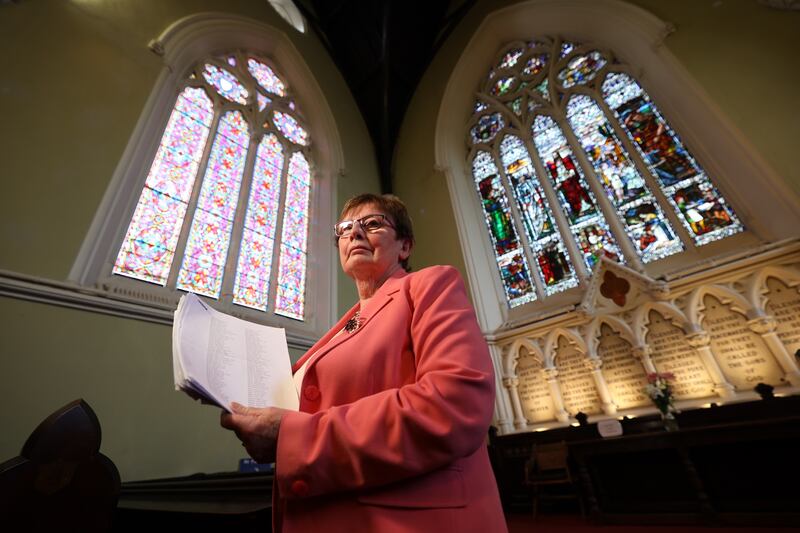“My father was murdered on the 25th February, 1977, when I was 12,” says Paula Rainey, on the steps of Dublin Unitarian Church on St Stephen’s Green. “His name was Joe Campbell, he was a member of the RUC and he was shot while closing the station in Cushendall. Where we lived was a very quiet, small place and [before that] the Troubles didn’t really bother us there.
“It was a very difficult time, for my mum, my family,” she explains with a slight tremble in her voice, the growing tears illustrating the pain lingering to this day. “We’re now at the 25th anniversary of the Good Friday Agreement, which we probably never thought we would see in our lifetimes. But for me, as a victim I feel inconvenient, the victims are largely forgotten about. And everybody wants to move forward.”
Rainey is in Dublin on Good Friday for a commemorative service for all those who died in the Troubles. For the 21st year running, Dublin Unitarian Church is hosting a three-hour service reading the close to 3,600 names of those who died during the Troubles.
“There’s something very therapeutic – the peace and the quiet – but there’s also something extremely sad about listening to lists of people who died,” she said.
READ MORE
The names are of soldiers, IRA members, loyalist paramilitaries, gardaí, civil rights marchers, farmers, taxi drivers, housewives, children. Names are of those walking home from the pub, sitting at home watching television, praying at church and travelling to the shops, from across Ireland and the UK.
From John Patrick Scullion, a Catholic storeman shot by the UVF in west Belfast in May 1966 through to 29-year-old journalist Lyra McKee, shot dead by the New IRA in Derry in April 2019, each name read is like a terrifying gong that just won’t stop.
“I’m used to reading, but when you’re reading them, you realise every single one was murdered,” says church minister Rev Bridget Spain. “It gives those dead people a voice just for the second it takes to read their names.”
This year marks 25 years of peace on the island after the Belfast Agreement was signed on Good Friday in 1998, but it comes at a critical juncture.
“Peace is on a knife-edge in Northern Ireland. To read 3,600 names of people who were murdered – such a waste of life – we don’t want to go back there, and if our publicity here makes somebody think back to what it was like then and say: ‘We’re not going there, can we work towards something better’ – it’s worthwhile,” Rev Spain said.

“I’m trying to say to people: Just think back to that time [in 1998] when everybody was so optimistic, and now it is not optimistic. Last night on the news, the PSNI gave a heightened warning of something bad going to happen in Derry, and that’s just wrong. [We must] think back to those good days and try and get back there and work on what was built 25 years ago.”
Also in attendance is 70-year-old Margaret Graham, who, as a nurse in Belfast in the early 1970s, dealt first hand with the aftermath of some of the worst atrocities of the time.
“We got the casualties of the Red Lion Pub bomb on the Ormeau Road,” she says of the bombing that killed three people after roughly a 10-second warning from the IRA. “It was just a shock. I was 18 and had six weeks of training, three weeks on a ward. That evening was just a blur, but I do remember the name of the bomb and the people killed.
“I was working on a surgical ward, and looking back I would say we had more casualties that were Troubles-related than anything to do with appendix, cancer and the ordinary procedures.”
Sixteen-year-old Grace Barry, a member of the church, volunteered to read a section of the names “to make sure we remember them”, she says.
“I think young people today do appreciate the peace, but I think we take a lot of it for granted because we just weren’t there when it happened. From the stories, it’s very hard to imagine it happening.
“It’s important we don’t forget our history and we don’t forget for the people who are a part of our history – and for their families, to let them know we still think about them.”
Graham remembers a radically different upbringing to the one reflected in the busy, sunny streets outside the Dublin city church.
“When I was a student, there was no social life, we made our own entertainment,” she says. “You wouldn’t have easily gone casually shopping in Belfast because you were going through barricades. There was no enjoyment in that. Belfast was dead... I don’t think [young people] realise how much a difference having the Good Friday Agreement and having the ceasefires kept in place, what it has made.
“We’ve no government at the moment – which is a pity – but people need to keep talking because there will always be a few that want to try and rattle the cages.”
For Paula Rainey, explaining the Troubles to young people today can be difficult.
“They haven’t suffered the life we suffered,” she says. “Silly things like going into a restaurant and sit facing the door, because I was taught from a young age to watch the doors if you had to get out.
“I hear a lot of young and older people saying, ‘We don’t want to perpetuate it and we should be moving on.’ They’re not interested in the past. But there’s a very big group of [victims], even going by the list today, with ripples in the communities and down through generations. Something has to be resolved of that for everybody to be able to move forward and have the Ireland that we all want – and I think that’s what’s missing.”










